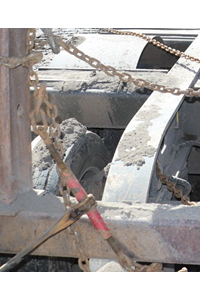Worker seriously injured when load shifted
Date of incident: May 2021
Notice of incident number: 2021178760016
Employer: Stone crushing firm; industrial construction firm
Incident summary
At a construction site, a worker was helping another worker secure equipment on a heavy-haul trailer when the load shifted, pinning the first worker. The worker sustained serious injuries.
Investigation conclusions
Cause
- Conveyor shifted forward while being secured, pinning worker. The 24 m long belt conveyor was loaded onto the trailer with the conveyor’s wheels resting on the trailer’s pedestals, and the feet of the conveyor’s legs on dunnage positioned across the frame of the trailer’s gooseneck. Two workers were securing the conveyor to the trailer using load securement chains and ratchet style boomers. While one of the workers was tightening two boomers and chains around the rear of the load (near the conveyor’s wheels), this motion pulled the conveyor forward so that its wheels rolled off the pedestals and its front legs slid off the dunnage. The other worker, who was between the conveyor and the frame of the gooseneck, was pinned between the two pieces of equipment.
Contributing factors
- Failure to identify hazards and assess risks.
- Two workers held an undocumented meeting at the incident site prior to the task of loading equipment onto the trailers. The worker who was later injured did not attend this meeting. The meeting focused on what order equipment was to be loaded onto the trailers and did not address the hazards associated with the task.
- One of the workers who had attended the meeting and the worker who had not loaded the conveyor onto the low-bed gooseneck trailer. The workers had all loaded conveyors onto longneck scissorneck trailers several times in the past, but only one of them had some experience loading conveyors onto a low-bed gooseneck trailer like the one involved in the incident.
- Lack of safe job procedures. The stone-crushing employer had a generic safe job procedure (SJP) that addressed driving equipment onto trailers. The workers did not have an SJP specific to the task of loading a long conveyor onto a low-bed gooseneck trailer. Nor had they seen the generic SJP.
- Inadequate supervision. The stone-crushing employer did not ensure that the workers were adequately trained for the task they were assigned to. Nor did the employer ensure the workers were supervised while rigging, slinging, and lifting equipment from the ground and placing it on a trailer. The hazards associated with the task or the change of equipment when a low-bed gooseneck trailer was used instead of the standard longneck scissorneck trailer had not been reviewed.
Other safety issues
- Rigging and slinging tasks performed by unqualified workers. The stone-crushing employer had unqualified workers rig and sling equipment for hoisting purposes. These untrained, unsupervised workers had rigged two load securement chains, not lifting slings, by draping them over the end teeth of the material bucket, which was not an engineered lifting point.
- Inadequate oversight by prime contractor. The prime contractor (the industrial construction firm) hired the stone-crushing employer as a subcontractor, but then failed to monitor and assess the subcontractor’s actions against its requirements. The prime contractor’s failure to review the subcontractor’s safety program and competency assessments caused the prime contractor to overlook key safety omissions on the part of the subcontractor. The subcontractor did not meet the prime contractor’s requirements in terms of providing services safely. The subcontractor had workers carrying out rigging and slinging tasks who were not trained in rigging and slinging. Although this lack of training did not contribute to the incident, it did not meet the prime contractor’s requirements that subcontractors’ workers assigned to its site be qualified for their allotted tasks. On the day of the incident, the prime contractor was aware that the subcontractor had completed its stone-crushing activities at the site but was not aware that the three workers were at the site and had started loading the crushing equipment for transport. The prime contractor did not ensure that they received its site-specific orientation before starting work at the site. If the subcontractor’s workers had received that orientation, they might have availed themselves of the first-aid services on site after the incident. These failings contravened the prime contractor requirements of the Workers Compensation Act and the prime contractor’s own policies regarding subcontractors’ workers.
2021-04-22 20:42:33

